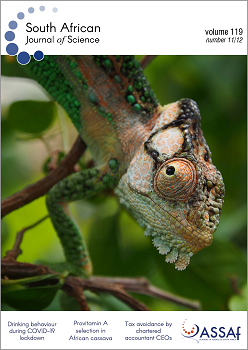The pros and cons of buccal swabbing and tail clipping for monitoring reptilian biodiversity
DOI:
https://doi.org/10.17159/sajs.2023/16217Keywords:
Bradypodion, animal welfare, tail autotomy, non-disruptive, small reptilesAbstract
In biodiversity research, the retrieval of genetic material from organisms is a common and essential component for assessing genetic diversity. The welfare of the organism, however, needs to be balanced against the overall goal of the intended research. One sampling technique often applied to retrieve DNA material from small reptiles is the removal of a small portion of the distal end of the tail. While most squamate reptiles have tail autotomy, some species (e.g. many iguanid lizards and snakes) do not regenerate tail tissue. We therefore explored the efficacy of a minimally disruptive technique, buccal swabbing, as an alternative to tissue sampling via tail clipping, particularly for species without tail autotomy, using dwarf chameleons (Bradypodion spp.) as a case study. The two sampling techniques were compared to assess the efficacy of DNA retrieval. We also evaluated the financial implications of each technique. The results indicate that buccal swabs paired with a specialised DNA extraction kit offer a feasible (although expensive), once-off alternative to tissue sampling, but with no material left for biobanking. Deviations in swab type used and the DNA extraction process (i.e. using more affordable extraction procedures) resulted in poor DNA retrieval and unreadable sequences. This finding suggests that buccal swabbing can be a suitable alternative when finances are not constrained, an expensive extraction kit is available, and biobanking is not a concern. For researchers from low- to middle-income economies, this expensive alternative may hamper research progress by placing a financial obstacle in the way, and therefore the next best option is tissue sampling.
Significance:
This study provides guidance on the efficacy of buccal swabs as a viable alternative to tissue samples collected via tail clipping for DNA retrieval from small reptiles. The results indicate that swabs may be a feasible alternative to tissue samples when finances are not constrained. Deviations in buccal swabbing method (i.e. using more cost-effective alternatives) performed poorly in DNA retrieval and do not offer competitive alternatives to tissue samples. Although buccal swabs were shown to offer an alternative to tissue samples, the financial implications to research in low- to middle-income economies may hinder research goals unnecessarily.
Downloads
Published
Issue
Section
License

All articles are published under a Creative Commons Attribution 4.0 International Licence
Copyright is retained by the authors. Readers are welcome to reproduce, share and adapt the content without permission provided the source is attributed.
Disclaimer: The publisher and editors accept no responsibility for statements made by the authors
How to Cite
- Abstract 482
- PDF 986
- EPUB 706
- XML 126
- Supplementary material 438
Funding data
-
National Research Foundation
Grant numbers 136381













.png)